Influence of Polymer Modifiers on Selected Properties and Microstructure of Cement Waterproofing Mortars
Abstract
:Highlights
- Effects of different polymer latexes on watertightness and adhesion.
- Microstructures of polymer-modified mortars.
1. Introduction
2. Experimental Material and Testing Method
2.1. Experimental Material
- ZH1/ASA—Styrene-acrylic copolymer—in the form of an aqueous dispersion with a solids content of 55–57%, a grain size of 200–400 nm, an MFFT temperature of 1 °C, and a styrene:acrylic ratio of 6:4.
- ZH2/CF/EVA—EVA ethylene-vinyl acetate copolymer—redispersible powder with an average particle size of 90 µm and an MFFT temperature of 0 °C, with 20% of ethylene.
- ZH3/ORG/VAAc—VAAc vinyl acetate-acrylic copolymer—hydrophobic redispersible powder with an MFFT temperature of 0 °C.
- ZH4/VA/VeoVa—vinyl acetate-vinyl versatate-acrylic VA/VeoVa/acrylic terpolymer—redispersible powder with an MFFT temperature of 0 °C.
2.2. Experimental Procedure
3. Test Results and Analyses
3.1. Water Permeability
3.2. Adhesion of the Mortar to Concrete Substrate
3.3. The Microstructure of Mortars
4. Discussion
5. Conclusions
- Both water permeability as well as the adhesion of waterproofing mortars to substrates largely depend on the tendency of a polymer to disperse with cement and aggregates in the fresh mortar.
- The greatest impact on the water permeability of mortars was by the ZH2/CF/EVA modifier, i.e., the EVA-based ethylene-vinyl acetate copolymer. In fresh mortars it was easily dispersed, and after hardening it formed a homogeneous cement–polymer paste with evenly distributed hydrates and finer aggregates, which tightly filled the inter-grain space of the mortar.
- No significant effect on the adhesion and tightness of the mortars was noted after a change in the amount of cement. This problem, however, requires more research in the future.
- The powder form of the polymer modifiers was not a contra-indication to use. Polymer modifiers that were available on the market in the form of dry powders were characterized by an appropriate degree of dispersion in the mortar, which enabled the obtention of waterproofing mortars with adequate adhesion and watertightness.
Author Contributions
Funding
Institutional Review Board Statement
Informed Consent Statement
Conflicts of Interest
References
- Bae, S.-C.; Hyung, W.-G. Properties of Polymer Modified Mortars Using Re-dispersible Polymer Powders. J. Korea Inst. Build. Constr. 2013, 13, 235–241. [Google Scholar] [CrossRef]
- Ohama, Y. Principle of latex modification and some typical properties of latex-modified mortars and concretes adhe-sion; binders (materials); bond (paste to aggregate); carbonation; chlorides; curing; diffusion. Mater. J. 1987, 84, 511–518. [Google Scholar]
- Marceau, S.; Lespinasse, F.; Bellanger, J.; Mallet, C.; Boinski, F. Microstructure and mechanical properties of polymer-modified mortars. Eur. J. Environ. Civ. Eng. 2012, 16, 571–581. [Google Scholar] [CrossRef]
- Van Gemert, D.; Czarnecki, L.; Maultzsch, M.; Schorn, H.; Beeldens, A.; Łukowski, P.; Knapen, E. Cement concrete and concrete–polymer composites: Two merging worlds: A report from 11th ICPIC Congress in Berlin, 2004. Cem. Concr. Compos. 2005, 27, 926–933. [Google Scholar] [CrossRef] [Green Version]
- Dvorkin, L.; Dvorkin, O.; Garnitsky, Y.; Ribakov, Y. Adhesive and cohesive properties of glue cement mortars with addition of organic–mineral modifiers. Mater. Des. 2014, 53, 588–595. [Google Scholar] [CrossRef]
- Mansur, A.; Nascimento, O.L.D.; Vasconcelos, W.L.; Mansur, H. Chemical functionalization of ceramic tile surfaces by silane coupling agents: Polymer modified mortar adhesion mechanism implications. Mater. Res. 2008, 11, 293–302. [Google Scholar] [CrossRef] [Green Version]
- Afridi, M.; Ohama, Y.; Iqbal, M.; Demura, K. Water retention and adhesion of powdered and aqueous polymer-modified mortars. Cem. Concr. Compos. 1995, 17, 113–118. [Google Scholar] [CrossRef]
- Ganesan, S.; Mydin, A.O.; Sani, N.M.; Ani, A.I.C. Performance of Polymer Modified Mortar with Different Dosage of Polymeric Modifier. In MATEC Web of Conferences; EDP Sciences: Les Ulis, France, 2014. [Google Scholar]
- Mingyue, Z.; Weihong, Q.; Hongzhu, L.; Yingli, S. Synthesis of a novel polymerizable surfactant and its application in the emulsion polymerization of vi-nyl acetate, butyl acrylate, Veova 10, and hexafluorobutyl methacrylate. J. Appl. Polym. Sci. 2008, 107, 624–628. [Google Scholar] [CrossRef]
- Rudenko, I.I.; Konstantynovskyi, O.P.; Kovalchuk, A.V.; Nikolainko, M.V.; Obremsky, D.V. Efficiency of redispersible polymer powders in mortars for anchoring application based on alkali ac-tivated Portland cements. Key Eng Mater. 2018, 761, 27–30. [Google Scholar] [CrossRef]
- Gomes, C.E.M.; Ferreira, O.P. Analyses of microstructural properties of VA/VeoVA copolymer modified cement pastes. Polímeros 2005, 15, 193–198. [Google Scholar] [CrossRef]
- Brady, J.; Dürig, T.; Lee, P.; Li, J.-X. Polymer Properties and Characterization. Dev. Solid Oral Dos. Forms 2017, 181–223. [Google Scholar] [CrossRef]
- Felton, L.A. Mechanisms of polymeric film formation. Int. J. Pharm. 2013, 457, 423–427. [Google Scholar] [CrossRef] [PubMed]
- Yamak, H.B. Emulsion polymerization: Effects of polymerization variables on the properties of vinyl acetate based emulsion polymers. In Polymer Science; IntechOpen: Rijeka, Croatia, 2013. [Google Scholar]
- Yu, C.; Ma, J.; Wang, W. Preparation of Redispersible Emulsion Powder by Spray Drying. Int. J. Food Eng. 2010, 6, 1840. [Google Scholar] [CrossRef]
- Afridi, M.; Ohama, Y.; Demura, K.; Iqbal, M. Development of polymer films by the coalescence of polymer particles in powdered and aqueous polymer-modified mortars. Cem. Concr. Res. 2003, 33, 1715–1721. [Google Scholar] [CrossRef]
- Adler, K.K. The use of redispersible powders in PMC in Europe. In Proceedings of the 3rd Southern African Conference on Polymers in Concrete, Johannesburg, South Africa, 15–17 July 1997; p. 25. [Google Scholar]
- Christensen, K.; Pedersen, G.; Kristensen, H. Preparation of redispersible dry emulsions by spray drying. Int. J. Pharm. 2001, 212, 187–194. [Google Scholar] [CrossRef]
- Sakai, E.; Sugita, J. Composite mechanism of polymer modified cement. Cem. Concr. Res. 1995, 25, 127–135. [Google Scholar] [CrossRef]
- Czarnecki, L.; Łukowski, P. Naprawy i ochrona konstrukcji betonowych w świetle norm europejskich. Bud. Technol. Archit. 2008, 4, 52–55. [Google Scholar]
- Cement–Part 1: Composition, Specifications and Conformity Criteria for Common Cements; PN-EN 197-1:2012; Polish Committee for Standardization: Warsaw, Poland, 2013.
- Building Lime—Part 12. Definition, Specification and Conformity Criteria; PN-EN 459-1:2015-06; British Standards Institution (BSI): London, UK, 2015.
- Ohama, Y.; Demura, K.; Ogi, T. Mix Proportioning and Properties of Epoxy-Modified Mortars. In Brittle Matrix Composites 2; Springer: Dordrecht, The Netherlands, 1989; pp. 516–525. [Google Scholar]
- Ohama, Y. Mix design system for polymer-modified mortars. In Proceedings of the Second Australian Conference on Engineering Materials, Sydney, Australia, 6–8 July 1981. [Google Scholar]
- Liquid Applied Water Impermeable Products for Use Beneath Ceramic Tiling Bonded with Adhe-sives—Requirements, Test Methods, Assessment and Verification of Constancy of Performance, Classification and Marking; Standard EN 14891:2017; British Standards Institution (BSI): London, UK, 2017.
- Jenni, A.; Holzer, L.; Zurbriggen, R.; Herwegh, M. Influence of polymers on microstructure and adhesive strength of cementitious tile adhesive mortars. Cem. Concr. Res. 2005, 35, 35–50. [Google Scholar] [CrossRef]
- Afridi, M.; Ohama, Y.; Demura, K.; Iqbal, M. A note on the comparison of crack resistance of Ca(OH)2 crystals of unmodified and polymer-modified mortars in carbonated atmosphere. Cem. Concr. Res. 2001, 31, 1643–1645. [Google Scholar] [CrossRef]
- Łukowski, P. Modyfikacja Materiałowa Betonu; Stowarzyszenie Producentów Cementu: Kraków, Poland, 2016. [Google Scholar]


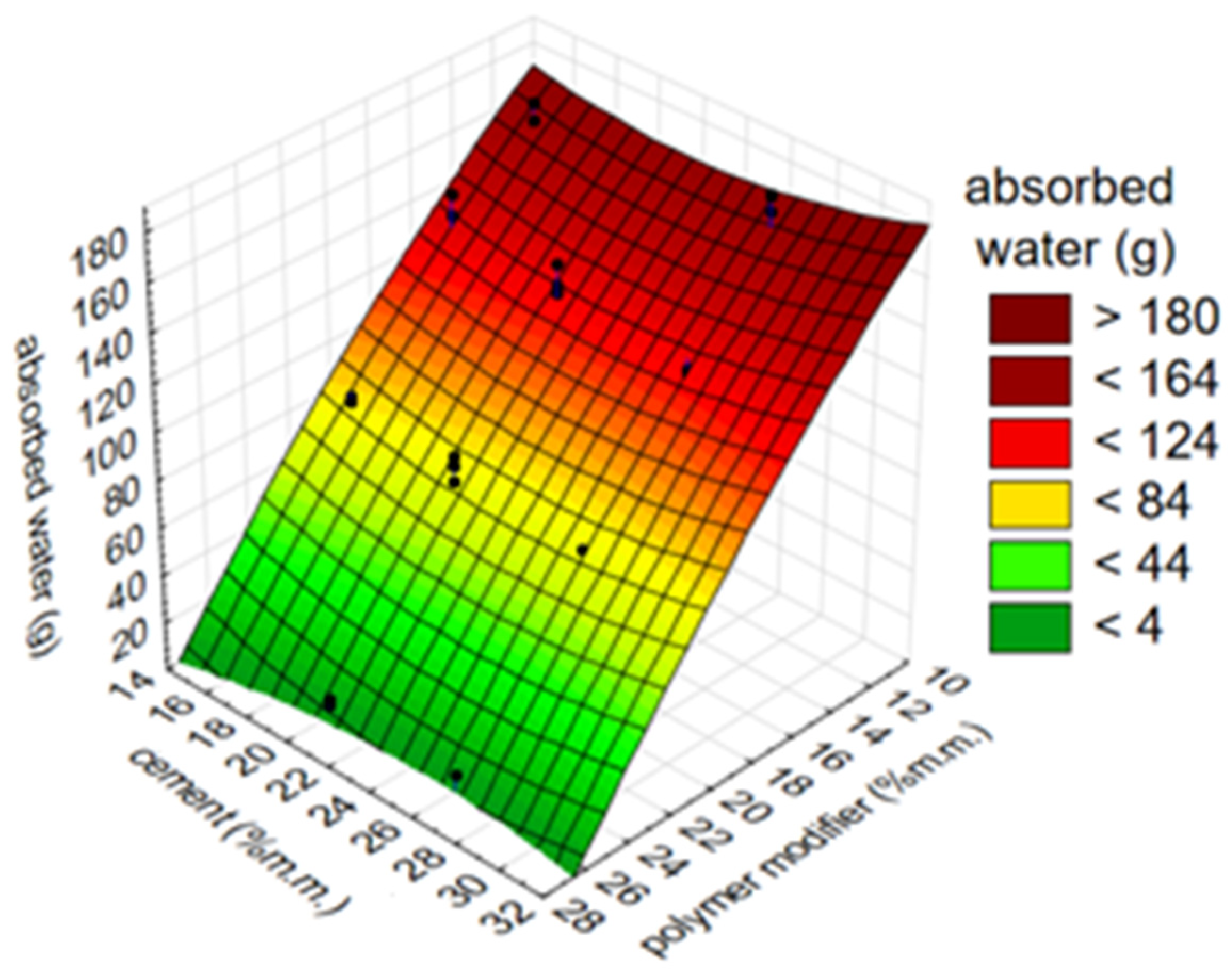

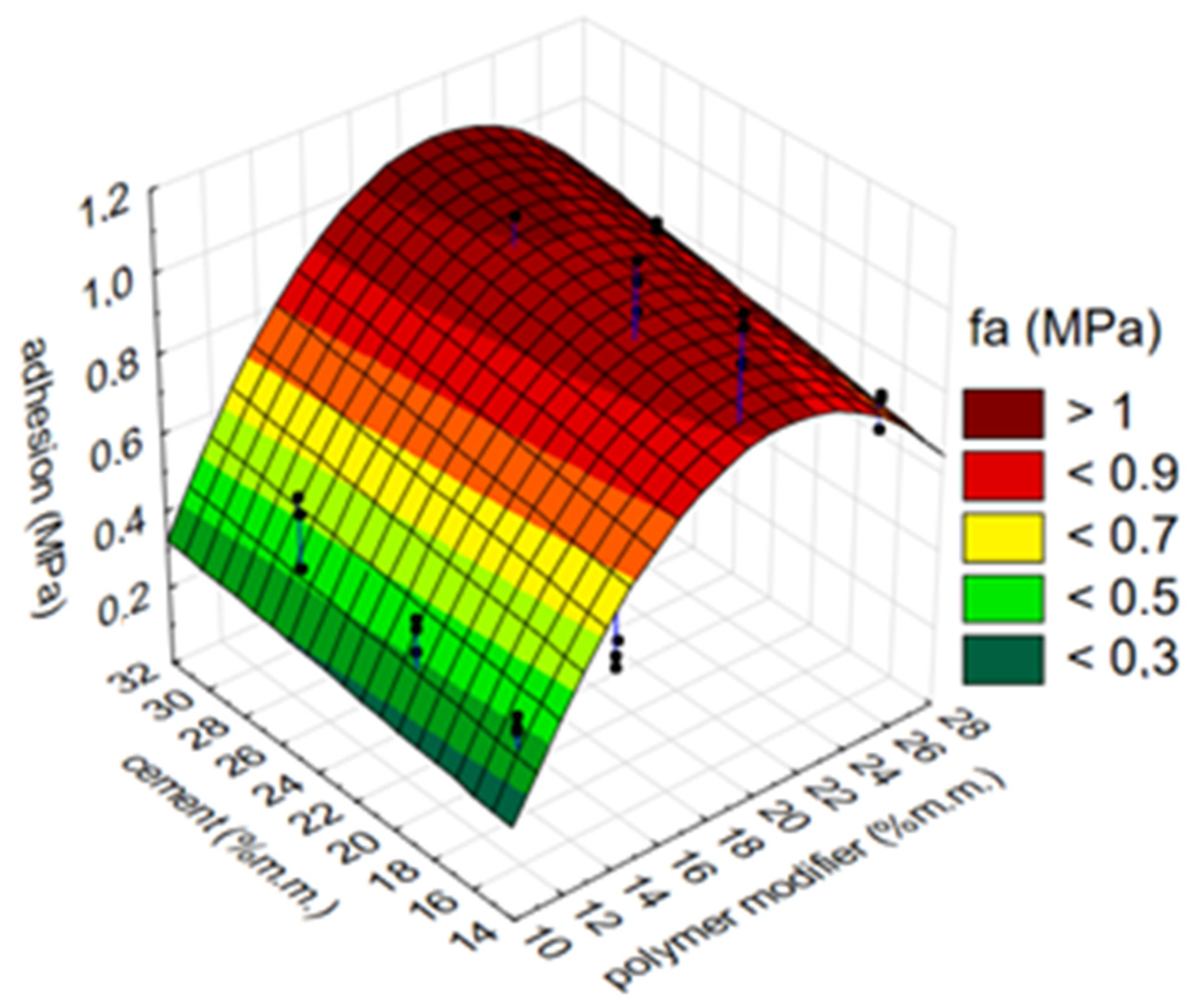
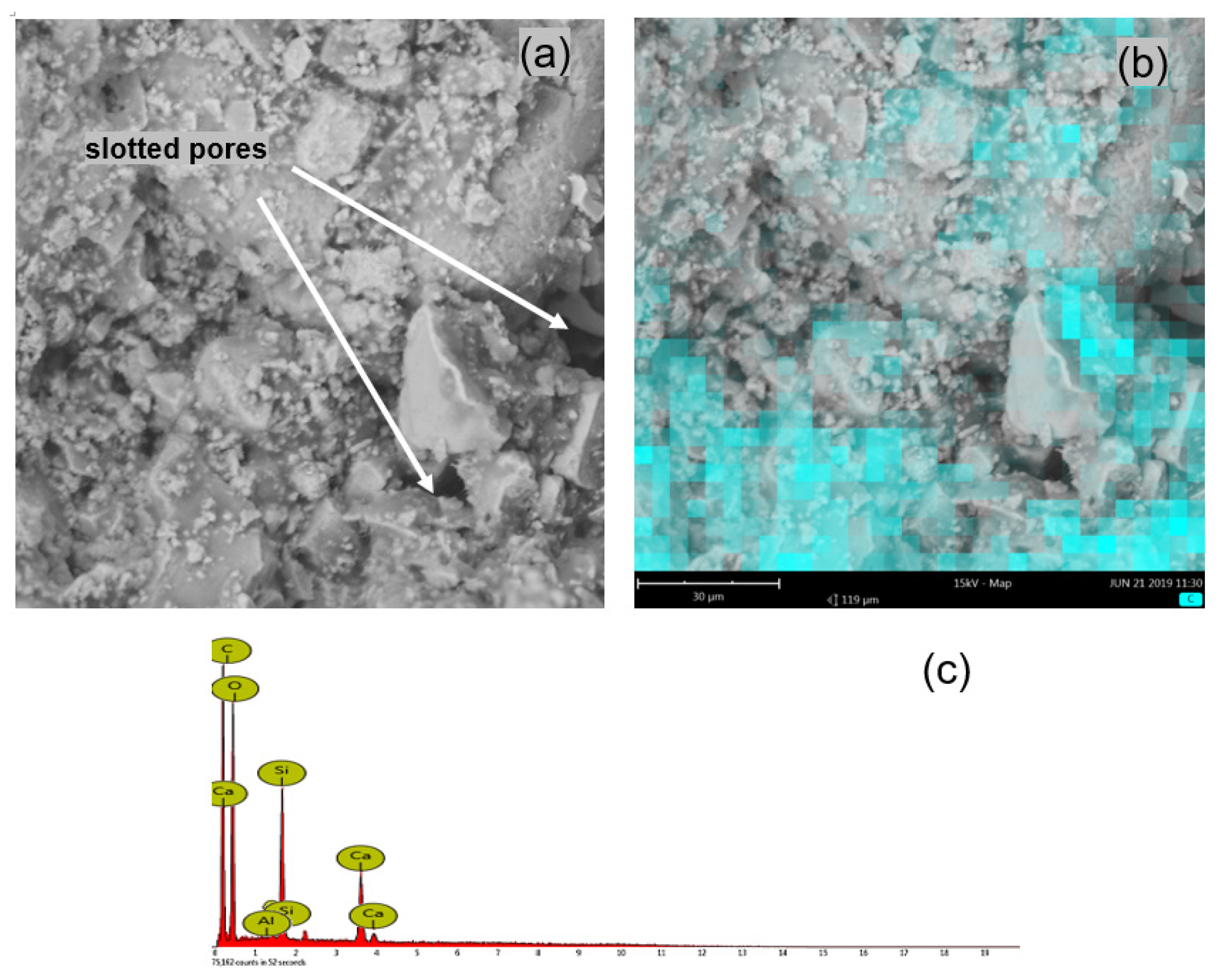
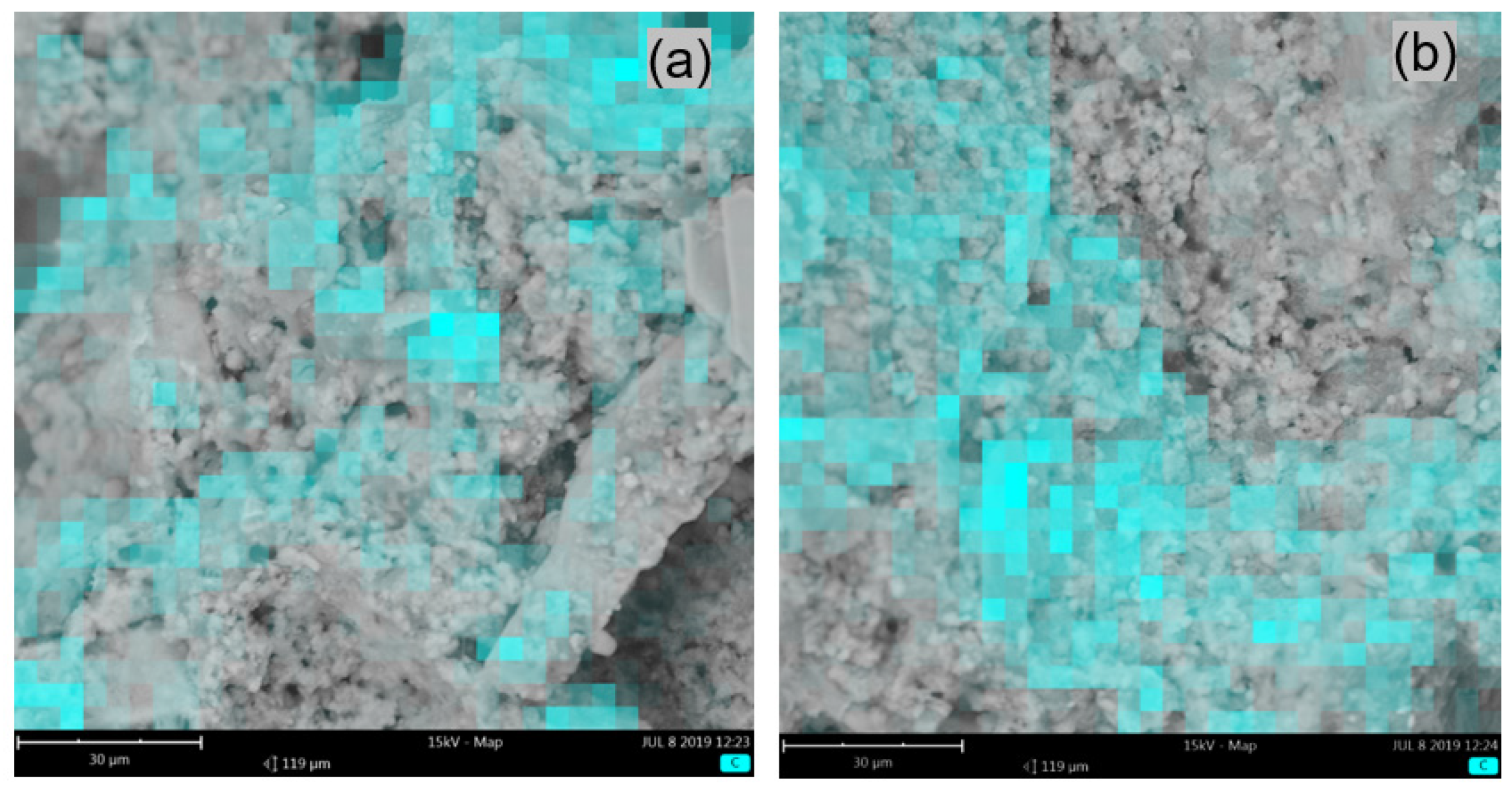
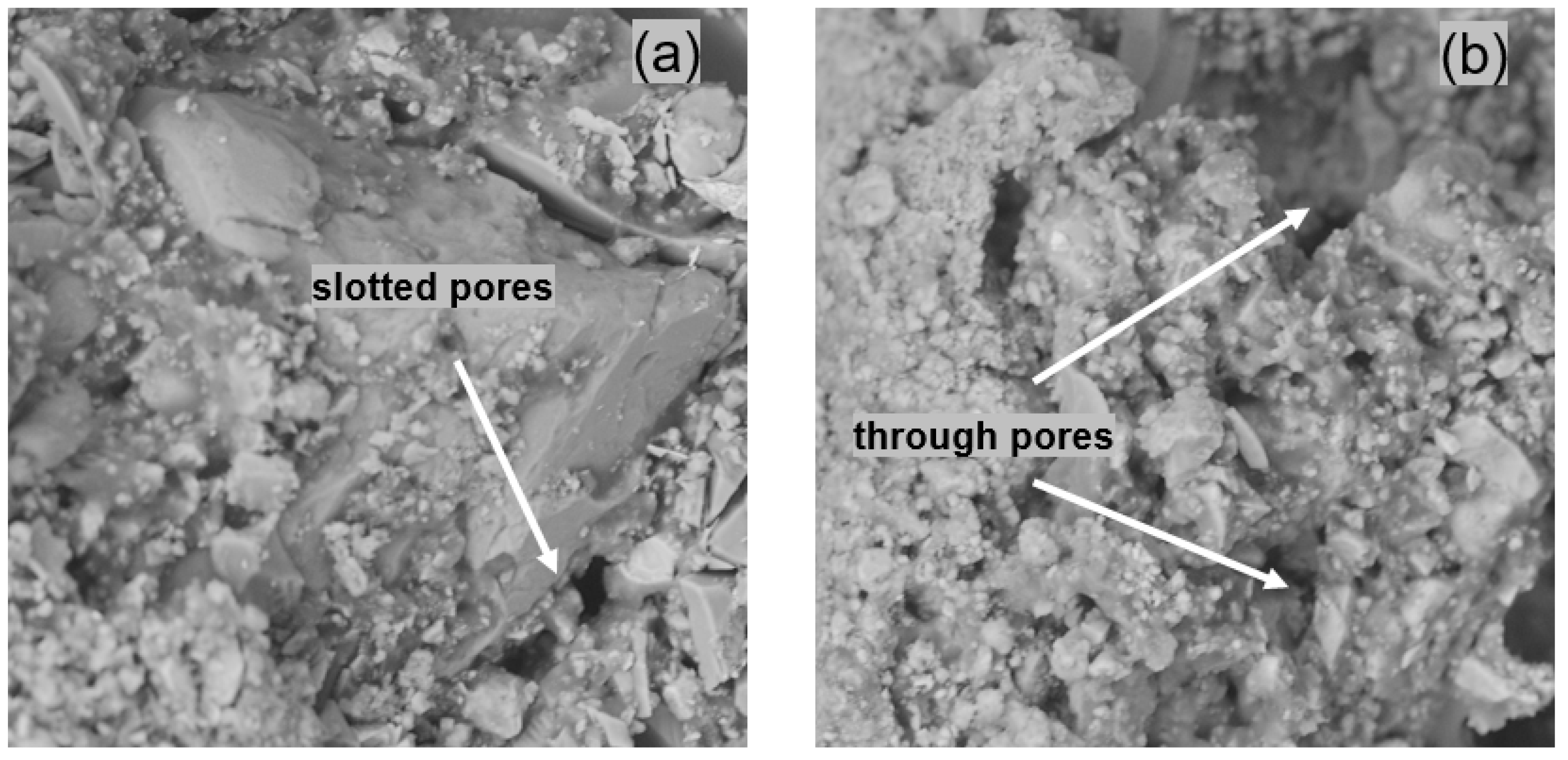
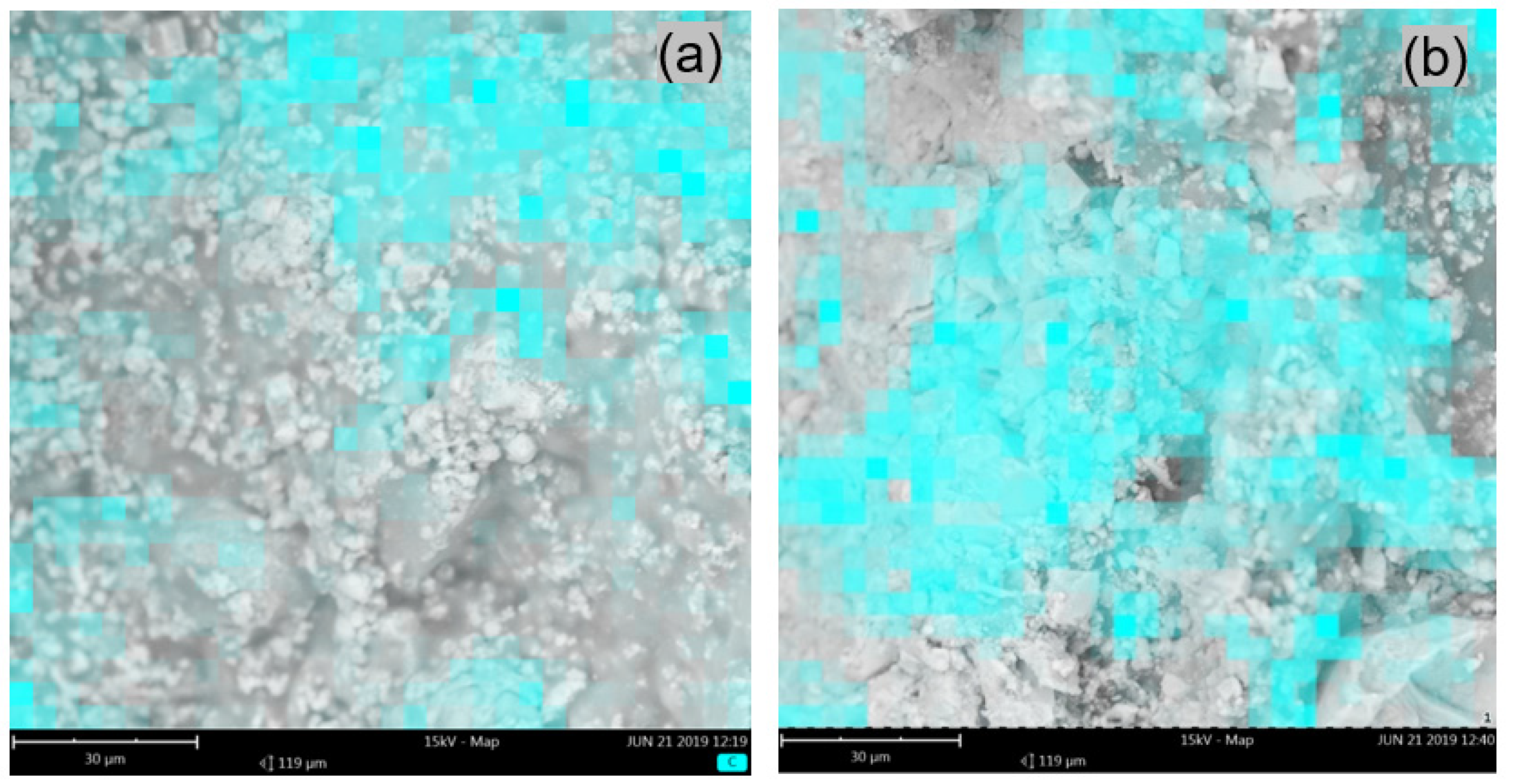
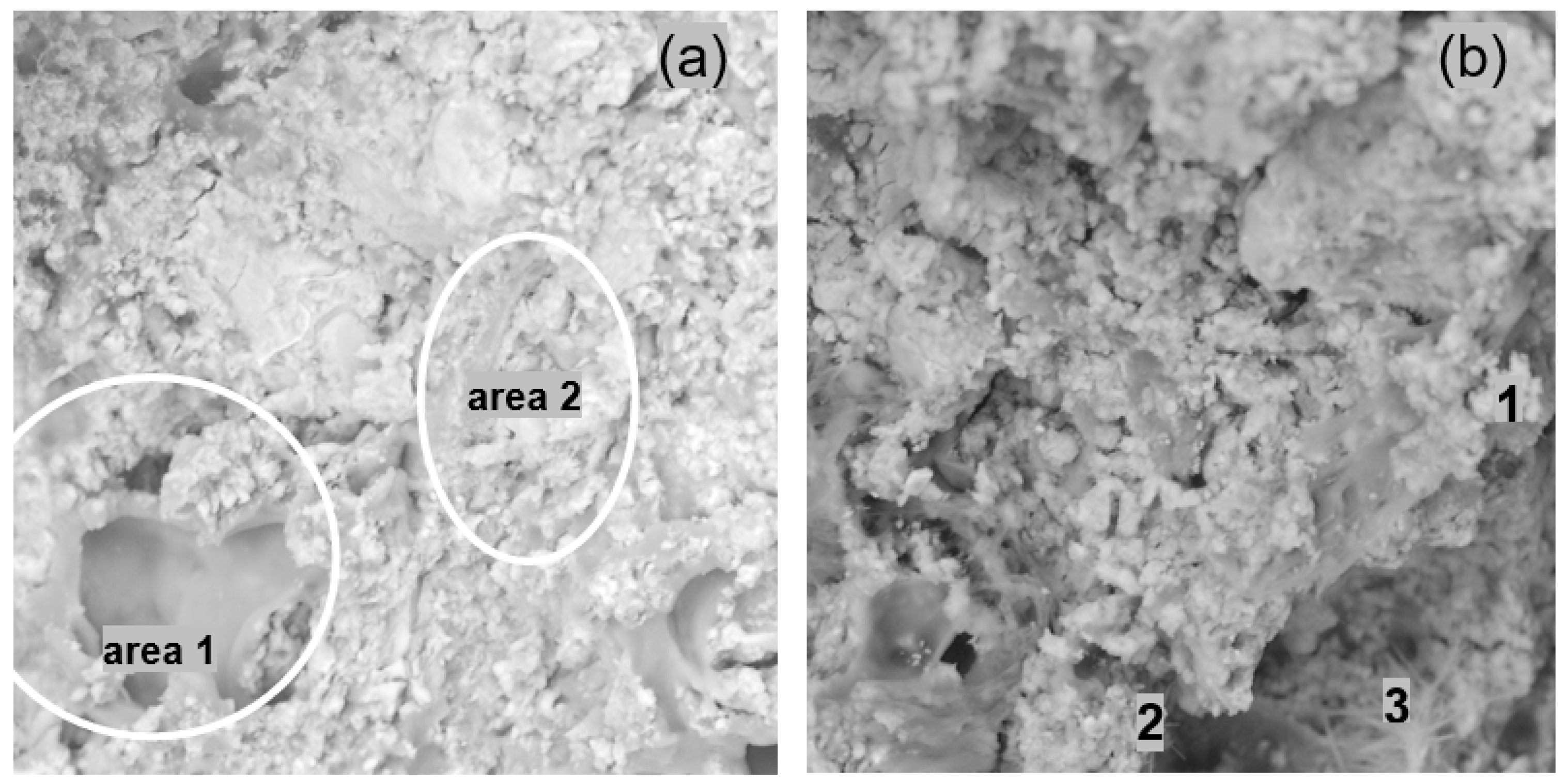

| Chemical Composition [% by Weight] | Mineral Composition [% by Weight] | ||||||||||||
|---|---|---|---|---|---|---|---|---|---|---|---|---|---|
| Loss on ignition | SiO2 | AL2O3 | Fe2O3 | CaO | MgO | SO3 | Cl- | Na2O | K2O | C3S | C2S | C3A | C4AF |
| 2.24 | 20.6 | 5.0 | 2.6 | 64.2 | 1.4 | 2.9 | 0.05 | 0.15 | 0.78 | 67.0 | 12.8 | 9.1 | 7.6 |
| Property | Unit | Obtained Result |
|---|---|---|
| Specific surface area | cm2/g | 3800 |
| Constancy of volume | mm | 0.2 |
| Initial setting time | minutes | 202 |
| Compressive strength after: | ||
| 2 days | MPa | 28.8 |
| 28 days | MPa | 58.2 |
| Component | Portion (% m/m) |
|---|---|
| CEM I 42.5 R Portland cement | 15.00 |
| CL 90-S Ca(OH)2 hydrated lime | 3.00 |
| Polymer modifier | 15.0%; 20.0%; 26.0% |
| Quartz powder 0.0–0.1 | 1.00 |
| Quartz sand 0.1–0.3 | 4.03 |
| Quartz sand 0.0–0.5 | 55.90 |
| Modified Methyl Hydroxy Propyl Cellulose | 0.10 |
| Starch ether 15 mPas | 0.03 |
| Cellulose fibre (length 300–700 μm) | 0.34 |
| Polypropylene fibre FPE | 0.60 |
| Total dry weight | 100 |
| Water | 28.00 |
| Water/cement (w/c) ratio | 1.87 |
Publisher’s Note: MDPI stays neutral with regard to jurisdictional claims in published maps and institutional affiliations. |
© 2021 by the authors. Licensee MDPI, Basel, Switzerland. This article is an open access article distributed under the terms and conditions of the Creative Commons Attribution (CC BY) license (https://creativecommons.org/licenses/by/4.0/).
Share and Cite
Brachaczek, W.; Chleboś, A.; Giergiczny, Z. Influence of Polymer Modifiers on Selected Properties and Microstructure of Cement Waterproofing Mortars. Materials 2021, 14, 7558. https://doi.org/10.3390/ma14247558
Brachaczek W, Chleboś A, Giergiczny Z. Influence of Polymer Modifiers on Selected Properties and Microstructure of Cement Waterproofing Mortars. Materials. 2021; 14(24):7558. https://doi.org/10.3390/ma14247558
Chicago/Turabian StyleBrachaczek, Wacław, Adam Chleboś, and Zbigniew Giergiczny. 2021. "Influence of Polymer Modifiers on Selected Properties and Microstructure of Cement Waterproofing Mortars" Materials 14, no. 24: 7558. https://doi.org/10.3390/ma14247558
APA StyleBrachaczek, W., Chleboś, A., & Giergiczny, Z. (2021). Influence of Polymer Modifiers on Selected Properties and Microstructure of Cement Waterproofing Mortars. Materials, 14(24), 7558. https://doi.org/10.3390/ma14247558






